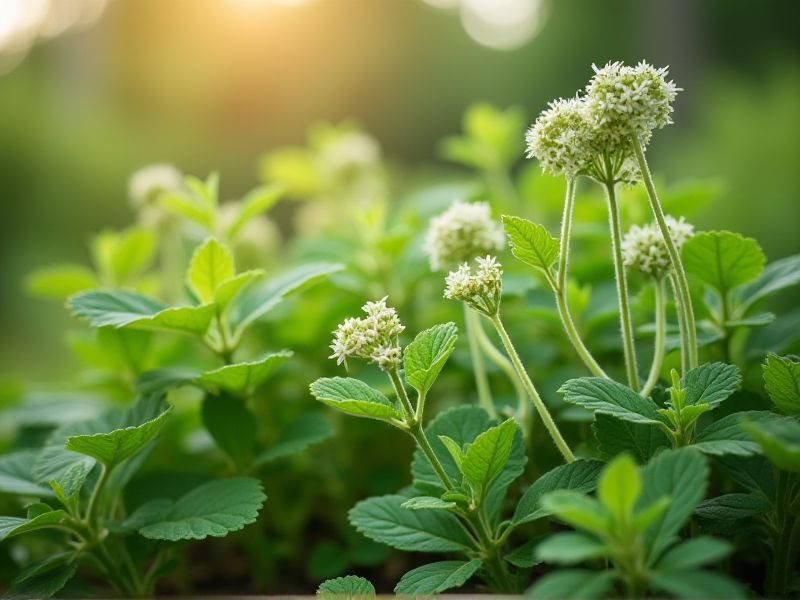
Herbal plants, such as basil, cilantro, and thyme, play a vital role in enhancing flavors in various cuisines worldwide. Basil, with its aromatic leaves, is a key ingredient in Italian dishes, particularly in pesto and Caprese salads. Cilantro, known for its fresh and citrusy taste, is essential in Mexican and Asian recipes, elevating salsas and curries alike. Thyme, a versatile herb, is frequently used in Mediterranean cooking, enriching stews, roasted meats, and vegetables with its earthy aroma. Incorporating these herbs into your cooking can not only boost flavor but also add nutritional benefits, making your meals more wholesome.
List of some Herbal plants that are used in cooking
- Basil (Ocimum basilicum)
- Rosemary (Salvia rosmarinus)
- Thyme (Thymus vulgaris)
- Oregano (Origanum vulgare)
- Sage (Salvia officinalis)
- Parsley (Petroselinum crispum)
- Mint (Mentha spicata)
- Cilantro (Coriandrum sativum)
- Dill (Anethum graveolens)
- Chives (Allium schoenoprasum)
Important things about Herbal plants that are used in cooking
Flavor Enhancement
Herbal plants are essential in culinary practices, adding depth and complexity to dishes. Common herbs like basil, known for its sweet and slightly peppery flavor, are often used in Mediterranean recipes, while cilantro provides a fresh, tangy note popular in Latin American cuisine. Thyme, with its earthy and minty aroma, enhances roasted meats and vegetables, making it a staple in French cooking. By incorporating these herbs, you can elevate your meals, transforming simple ingredients into unforgettable culinary experiences.
Nutritional Benefits
Herbal plants like basil, parsley, and cilantro not only enhance the flavor of dishes but also offer significant nutritional benefits. Basil is rich in antioxidants, particularly essential oils that contribute to reduced inflammation and improved heart health. Parsley is an excellent source of vitamins A, C, and K, promoting immune function and bone health. Incorporating cilantro into your meals can aid digestion and provide essential minerals, making these herbs valuable additions to a balanced diet.
Culinary Uses
Herbal plants such as basil, cilantro, and rosemary enhance the flavor profiles of various dishes in the culinary world. Basil, with its sweet and aromatic leaves, is commonly used in Italian cuisine, particularly in tomato sauces and pesto. Cilantro brings a fresh, citrusy note to many Mexican and Asian dishes, including salsa and pho, making it a versatile ingredient in your kitchen. Rosemary, known for its robust and woody flavor, pairs beautifully with roasted meats and vegetables, adding depth to your culinary creations.
Medicinal Properties
Herbal plants such as basil, rosemary, and thyme not only enhance the flavor of your dishes but also possess significant medicinal properties. Basil is known for its anti-inflammatory and antimicrobial benefits, making it a popular choice for bolstering your immune system. Rosemary contains antioxidants that may improve digestion and cognitive function, while thyme has antiseptic qualities that can aid in respiratory health. Incorporating these herbs into your cooking can provide both a delightful taste and numerous health benefits.
Fresh Vs. Dried
Fresh herbal plants, such as basil, cilantro, and parsley, offer vibrant flavors and essential nutrients in cooking. Their high moisture content enhances dishes with a burst of freshness, ideal for salads, sauces, and garnishes. In contrast, dried herbs like oregano, thyme, and rosemary deliver concentrated flavors, perfect for slow-cooked dishes and seasoning blends. While fresh herbs are typically used for finishing touches, dried variants provide a longer shelf life and can be conveniently stored, making them versatile kitchen staples.
Pairing With Ingredients
Herbal plants such as basil, cilantro, and rosemary enhance the flavor of various dishes, offering both culinary delight and health benefits. Basil, rich in essential oils, complements tomato sauces and salads, providing a fresh and aromatic taste. Cilantro, known for its unique and bold flavor, pairs beautifully with spicy foods, particularly in Mexican and Asian cuisines, adding a refreshing contrast. Rosemary, with its distinctive pine-like aroma, works well with roasted meats and vegetables, infusing dishes with a savory essence that elevates your cooking experience.
Growing Conditions
Herbal plants like basil, cilantro, and rosemary thrive best in warm, sunny environments with well-drained soil rich in organic matter. You can enhance their growth by ensuring consistent moisture without overwatering, as excessive water can lead to root rot. Fertilizing these herbs with a balanced, slow-release fertilizer during their growing season can promote lush foliage and robust flavors. Optimal harvesting techniques, such as picking the leaves in the morning when oils are most concentrated, not only improve taste but also encourage the plants to produce new growth.
Harvesting Techniques
Harvesting herbal plants for culinary use requires precise timing to ensure optimal flavor and potency. Ideally, you should gather leaves in the morning after the dew has dried, as this is when aromatic oils are at their peak. It's essential to use sharp, clean shears to avoid damaging the plant, allowing for continuous growth and regeneration. Popular culinary herbs like basil, cilantro, and thyme thrive when harvested correctly, enhancing your dishes with their vibrant flavors and health benefits.
Preservation Methods
Herbal plants like basil, thyme, and cilantro play a crucial role in enhancing the flavor profiles of various dishes. Preserving these herbs can be achieved through methods such as freezing, drying, and oil infusion, ensuring that their aromatic qualities remain intact. Freezing is particularly effective, as it retains the herbs' vibrant colors and essential oils, making them readily available for your culinary creations. Drying, on the other hand, concentrates the flavors, providing a long-lasting seasoning option that is ideal for year-round cooking.
Regional Significance
Herbal plants such as basil, cilantro, and parsley hold regional significance in various cuisines around the world, enriching dishes with their unique flavors and aromas. In Mediterranean cooking, basil is essential for pesto, while cilantro is a cornerstone in Mexican salsa and Southeast Asian dishes. Local varieties of these herbs often reflect the climate and soil conditions of their regions, influencing culinary traditions and practices. By incorporating these herbaceous plants into your meals, you not only enhance taste but also experience the rich cultural heritage that each herb embodies.
